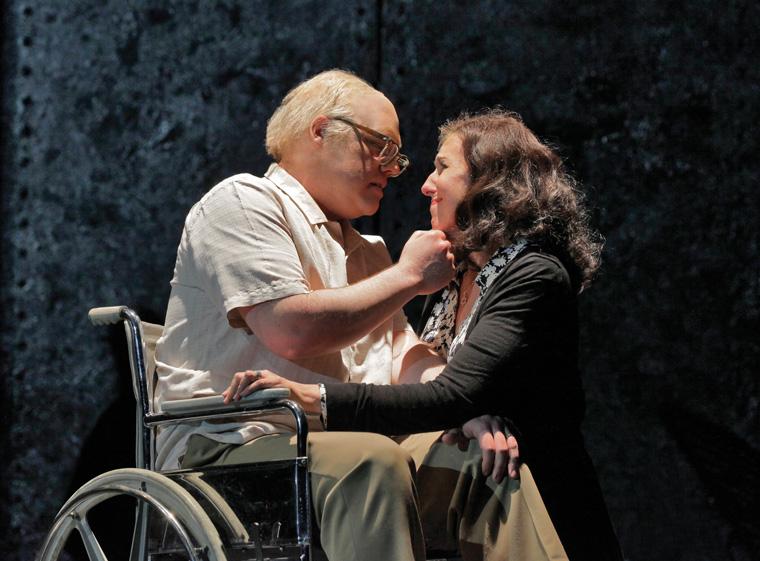The artistry of ‘Klinghoffer’
Published June 15, 2011
Let’s set the politics of “The Death of Klinghoffer” aside for a moment and look at what you’re getting into if you spend an evening at Opera Theatre of St. Louis (OTSL) with John Adams’ music and Alice Goodman’s libretto. Ultimately, any artwork intended for performance has to meet two tests: Does it work as a piece of art and is it entertaining?
An opera is a musical on steroids. The best are constructed just like a good Broadway musical. There’s a back-story, a plot involving conflict, and a resolution. One of the differences between a production designed for Broadway and an opera is that many operas, in fact most dramatic operas, do not have happy endings. Tragedy is serious opera’s meat.
“The Death of Klinghoffer” is based on a true story. In 1985, Palestinian terrorists took over a cruise ship, the Achille Lauro, and murdered an elderly, Jewish, wheelchair-bound passenger named Leon Klinghoffer. The hijackers were convinced to debark in Egypt. Four of them were tried, convicted and imprisoned. The fifth was caught by U.S. troops in Iraq in 2003 and died in custody. Adams’ opera dramatizes what happened aboard the ship.
ADVERTISEMENT
In many ways, this story should be perfect for Adams and Goodman. Their previous collaboration, “Nixon in China,” illustrated the internal conflicts of Cold War adversaries coming to terms with a changing world. In that opera, characters in conflict come in pairs. Arias – singers’ solos – are juxtaposed, as Adams and Goodman contrast the characters’ personal and political insecurities. We hear from Chairman Mao and President Nixon, Madame Mao and Pat Nixon, Chou En Lai and Henry Kissinger. It was a neat trick and, for the most part, Adams and Goodman pulled it off.
The Achille Lauro tragedy was also a microcosm of a long-term ideological and political conflict. The senselessness of Leon Klinghoffer’s death, the fulcrum on which the show balances, allows them to depict ordinary humans caught in the dehumanizing futility of a seemingly endless and unresolvable political struggle.
Adams’ musical style is as controversial as the subjects he tackles. He’s a modern composer of the Minimalist School. Minimalism isn’t necessarily about using fewer notes, or fewer instruments, as the name might suggest. It’s about creating melody in non-traditional ways.
ADVERTISEMENT
Much of Adams’ music is based on sets of repeated patterns, played over increasingly and/or decreasingly intense rhythms. It sounds like a recipe for boredom, but I learned from experiencing “Nixon in China” at an OTSL production a couple of years ago, that Adams has the facility to pile up melody and rhythm in a way that creates stunningly beautiful music. He also understands that melding the degree of musical tension to the intensity of his librettist’s words is the key to sustaining the drama.
One of the creative benefits of this kind of composing is that it gives singers a lot of freedom. They are not so much singing traditional tunes, as surfing on a wave of interactive melodic figures and lighter and darker sets of repeated rhythms. Adams music is an organism with a pulse. When it’s working, the pulse rises and falls responding elegantly to the characters’ emotions and situations. A talented opera singer can wring electrifying emotion out of this music in a way that someone crooning a traditional melodic line in simple time couldn’t. If “Nixon in China” was an accurate example, the unusually gifted voices and generally inspired performances OTSL’s directors and conductors extract from their vocalists should yield a night of inspired singing.
In “Nixon in China,” the music builds force and passion to a soaring climax. “Klinghoffer” has more ups and downs. Arias are contrasted with choral sections. The choral parts have more traditional melodies. The powerful chorales from “Klinghoffer” are so sumptuous they have been performed outside the opera as concert pieces and recorded as choral recitals on compact disc. Likewise, individual singers have the opportunity to create gorgeous arias. Brian Mulligan as Leon and Nancy Maultsby as Marilyn Klinghoffer have achingly sad music with which to work. Leon, singing from somewhere between death and life-the dead seem to sing a lot in opera-comes off as a real mensch and Marilyn’s aria upon learning her husband is dead, radiates grieving humanity.
Past productions of “The Death of Klinghoffer,” though rare, have been criticized for static staging and the orchestra overwhelming the singers. OTSL has re-scored the opera for a slightly reduced orchestra and uses St. Louis Symphony musicians who possess superb control and precision. Stage Director James Robinson, another OTSL veteran, has a history of deft staging. But even if done in the style of a Bach oratorio, somber narrative poetry book-ended by choral magnificence, the work of a world-class poet and the best classical composer alive should be worth your time.
Lew Prince is managing partner of Vintage Vinyl and regularly reviews opera for the Riverfront Times.
Opera Theatre of St. Louis
What: “The Death of Klinghoffer”
When: 8 p.m. June 15, 17, 23 &25; 7 p.m. June 19 and 1 p.m. June 21
Where: Loretto-Hilton Center, 130 Edgar Road, Webster University
How much: $25-$120
More info: 314.961.0644 or www.opera-stl.org

















